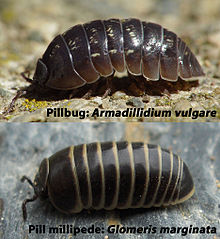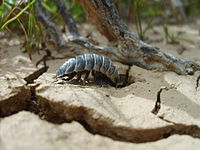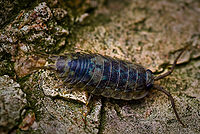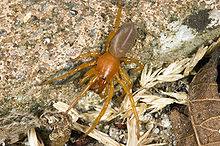- Woodlouse
-
Woodlouse 
Porcellio scaber (left) and Oniscus asellus (centre) living on fallen wood Scientific classification Kingdom: Animalia Phylum: Arthropoda Subphylum: Crustacea Class: Malacostraca Order: Isopoda Suborder: Oniscidea
Latreille, 1802Infraorders and sections - Diplocheta
- Holoverticata
- Tylida
- Microcheta
- Synocheta
- Crinocheta
A woodlouse (known by many common names: see below; plural woodlice) is a crustacean with a rigid, segmented, long exoskeleton and fourteen jointed limbs. Woodlice form the suborder Oniscidea within the order Isopoda, with over 3,000 known species.
Woodlice in the genus Armadillidium can roll up into an almost perfect sphere as a defensive mechanism, hence some of the common names such as pill bug or roly-poly. Most woodlice, however, cannot do this.[1]
Contents
Common names
Common names for woodlice vary throughout the English-speaking world. A number of common names make reference to the fact that some species of woodlice can roll up into a ball. Other names compare the woodlouse to a pig.
Names include: "armadillo bug",[2] "cheeselog" (Reading, Berkshire),[3] "cheesy bug" (North-West Kent),[4] "doodlebug" (also used for the larva of an antlion),[5] "pill bug" (usually applied only to the genus Armadillidium),[2] "potato bug",[6] "roly-poly",[6] "sow bug",[7] "roll up bug",[8] "chuggypig" or "chucky pig",[9] "slater",[10] "gramersow" (Cornwall),[11] "butcher boy" or "butchy boy" (Australia),[12] and "wood bug" (British Columbia, Canada).[13]
Description and life cycle
The woodlouse has a shell-like exoskeleton, which it must progressively shed as it grows. The moult takes place in two stages; the back half is lost first, followed two or three days later by the front. This method of moulting is different from that of most arthropods, which shed their cuticle in a single process. Metabolic rate is temperature-dependent in woodlice. In contrast to mammals and birds, invertebrates are not "self heating": the external environmental temperature relates directly to their rate of respiration.
A female woodlouse will keep fertilised eggs in a marsupium on the underside of her body until they hatch into small, white offspring. The mother then appears to "give birth" to her offspring.
Woodlice are not generally regarded as a serious household pest as they do not spread disease and do not damage wood or structures; however, their presence can indicate dampness problems.
Pillbugs and pill millipedes
Pillbugs (woodlice of the family Armadillidiidae) can be confused with pill millipedes.[14] Both of these groups of terrestrial segmented arthropods are about the same size. They live in very similar habitats, and they can both roll up into a ball. Pill millipedes and pillbugs appear superficially similar to the naked eye. This is an example of convergent evolution.
Pill millipedes can be distinguished from woodlice on the basis of having two pairs of legs per body segment instead of one pair like all isopods. Pill millipedes also have thirteen body segments, whereas the woodlouse has eleven. In addition, pill millipedes are smoother, and resemble normal millipedes in overall colouring and the shape of the segments.
Ecology
Environmental extremes
Living in a terrestrial environment, woodlice breathe through trachea-like lungs in their paddle-shaped hind legs (pleopods), called pleopodal lungs. Woodlice need moisture because they rapidly lose water by excretion and through their cuticle, and so are usually found in damp, dark places, such as under rocks and logs, although one species, Hemilepistus reaumuri, inhabits "the driest habitat conquered by any species of crustacean".[15] They are usually nocturnal and are detritivores, feeding mostly on dead plant matter, although they have been known to feed on cultivated plants, such as ripening strawberries and tender seedlings. Woodlice then recycle the nutrients back into the soil. In artificial environments such as greenhouses where it can be very moist, woodlice may become abundant and damage young plants.[16]
Few woodlice have returned to water. Evolutionary ancient species are amphibious, such as the marine-intertidal sea slater (Ligia oceanica), which belongs to family Ligiidae.
Other examples include some Haloniscus species from Australia (family Scyphacidae), and in the northern hemisphere several species of Trichoniscidae and Thailandoniscus annae (family Styloniscidae). Species for which aquatic life is assumed include Typhlotricholigoides aquaticus (Mexico) and Cantabroniscus primitivus (Spain).[17]
Woodlice are eaten by a wide range of insectivores, but the only animals known to prey exclusively on woodlice are spiders of the genus Dysdera, such as the woodlouse spider Dysdera crocata.[7]
British Isles
Main article: List of woodlice of the British IslesThere are over 40 native or naturalised species of woodlouse in the British Isles, ranging in colour and in size (3–30 millimetres or 0.1–1.2 inches) of which only five are common: Oniscus asellus (the common shiny woodlouse), Porcellio scaber (the common rough woodlouse), Philoscia muscorum (the common striped woodlouse), Trichoniscus pusillus (the common pygmy woodlouse), and Armadillidium vulgare (the common pill bug).
Classification
- Infraorder/Section Diplocheta
-
- Ligiidae
- Infraorder Holoverticata
- Section: Tylida
-
- Tylidae
- Section: Microcheta
-
- Mesoniscidae
- Section: Synocheta
-
- Buddelundiellidae
- Schoebliidae
- Styloniscidae
- Titaniidae
- Trichoniscidae
- Tunanoniscidae
- Section: Crinocheta
-
- Agnaridae
- Alloniscidae
- Armadillidae
- Armadillidiidae
- Balloniscidae
- Bathytropidae
- Berytoniscidae
- Cylisticidae
- Delatorreidae
- Detonidae
- Eubelidae
- Halophilosciidae
- Olibrinidae
- Oniscidae
- Philosciidae
- Platyarthridae
- Porcellionidae
- Pudeoniscidae
- Rhyscotidae
- Scleropactidae
- Scyphacidae
- Spelaeoniscidae
- Stenoniscidae
- Tendosphaeridae
- Trachelipodidae
References
- ^ "Suborder Oniscidea". Bug Guide. March 25, 2009. http://bugguide.net/node/view/15976.
- ^ a b Bill Amos (August 10, 2002). "Little armored tanks". Caledonian-Record. http://www.caledonianrecord.com/pages/hidden_worlds/story/af246319d.
- ^ Paul Kerswill. "The sound of Reddin". BBC. http://www.bbc.co.uk/berkshire/content/articles/2005/01/26/voices_linguist_interview_feature.shtml. Retrieved September 17, 2006.
- ^ "Dave the blog: Cheesybug". http://dave-east.blogspot.com/2008/01/cheesybug.html. Retrieved August 18, 2009.
- ^ ""Sow bug"". Dictionary.com Unabridged (v 1.0.1). 2006. http://dictionary.reference.com/search?q=sow%20bug. Retrieved August 17, 2006.
- ^ a b Bert Vaux & Scott A. Golder. "Dialect Survey". Harvard University. Archived from the original on September 3, 2006. http://web.archive.org/web/20060903212243/http://cfprod01.imt.uwm.edu/Dept/FLL/linguistics/dialect/staticmaps/q_74.html. Retrieved September 30, 2006.
- ^ a b Bruce Marlin. "Common Woodlouse, Sow Bug, Pillbug". North American Insects and Spiders. http://www.cirrusimage.com/isopoda_sow_bug.htm. Retrieved February 10, 2009.
- ^ Gail Smith-Arrants (March 20, 2004). "You say potato bug, I say roly-poly, you say…" (PDF). Charlotte Observer. http://www.uwm.edu/~vaux/you-say-potato-bug.pdf.
- ^ "365 Urban Species. #093: Woodlouse". The Urban Pantheist. http://urbpan.livejournal.com/251568.html. Retrieved January 18, 2009.
- ^ Maria Minor & A. W. Robertson (2006). "Guide to New Zealand soil invertebrates: Isopoda". Massey University. http://soilbugs.massey.ac.nz/isopoda.php. Retrieved May 13, 2007.
- ^ Matthew Francis (2004). Where the People Are: Language and Community in the Poetry of W.S. Graham. Salt Publishing. ISBN 1876857234. http://books.google.com/?id=Yt_7fiLj7Z0C&pg=PT193&lpg=PT193&dq=gramersow.
- ^ "Bugs Bugs Bugs!" (PDF). Museum Victoria. http://www.museumvictoria.museum/pages/2085/bugs-bugs-bugs-introduction.pdf. Retrieved March 30, 2010.
- ^ "Wood Bug". Vancouver Sun. November 26, 2007. http://www.canada.com/vancouversun/features/urban_critters/story.html?id=6f9e1efc-6f84-4591-b19b-e4a9eb89772b&k=21357.
- ^ "Pill woodlouse (Armadillidium vulgare)". ARKive.org. http://www.arkive.org/pill-woodlouse/armadillidium-vulgare/info.html. Retrieved February 13, 2009.
- ^ Rod Preston-Mafham & Ken Preston-Mafham (1993). "Crustacea. Woodlice, crabs". The Encyclopedia of Land Invertebrate Behavior. MIT Press. p. 161. ISBN 9780262161374. http://books.google.co.uk/books?id=sDpagGxJw3AC&pg=PA161.
- ^ Phillip E. Sloderbeck (2004). "Pillbugs and sowbugs". Kansas State University. http://www.oznet.ksu.edu/library/entml2/ep120.pdf.
- ^ Ivo Karaman (2003). "Macedonethes stankoi n. sp., a rhithral oniscidean isopod (Isopoda: Oniscidea: Trichoniscidae) from Macedonia". Organisms Diversity & Evolution 3 (8): 1–15. doi:10.1078/1439-6092-00054. http://www.senckenberg.de/odes/03-08.pdf.
External links
 Media related to Oniscidea at Wikimedia Commons
Media related to Oniscidea at Wikimedia Commons Data related to Oniscidea at Wikispecies
Data related to Oniscidea at Wikispecies
Further reading
- Christian Schmidt & Andreas Leistikow (2004). "Catalogue of the terrestrial Isopoda (Crustacea: Isopoda: Oniscidea)". Steenstrupia 28 (1): 1–118. http://www.zmuc.dk/commonweb/JOURNALS/PDF/Vol28-1/Schmidt&Leistikow.pdf. (lists all genera published up to the end of 2001)
Categories:- Woodlice
- Isopods
- Terrestrial crustaceans
- Detritivores
Wikimedia Foundation. 2010.




